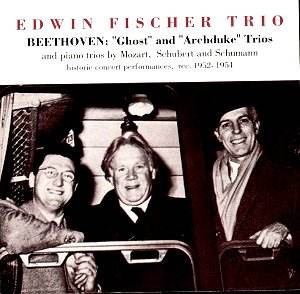Edwin Fischer first formed his trio in 1935.
Enrico Mainardi was the cellist and was to remain thus for the
remainder of the trio’s existence but the original violinist was
Georg Kulenkampff. The three original members proved congenial.
Fischer and Mainardi were duo partners and Mainardi and Kulenkampff
often played Brahms’ Double Concerto together (they recorded it
as well in a fine reading). The name of Adolf Busch has sometimes
been used as a stick with which to beat Kulenkampff in respect
of selfless altruism and moral scruple during the Nazi’s rise
to power – but what is true in this context, concerning Mainardi,
is that his career in Germany in the thirties flourished in direct
proportion to the enforced emigration of leading cellists. The
trio carried on after the war, by which time Kulenkampff and Fischer
were living in Switzerland and on the violinist’s sudden death
in 1948, Wolfgang Schneiderhan took over. The original trio made
no discs and as far as is known no live recordings have survived
either. The new trio however was taped on a number of occasions
in concerts both by Bavarian Radio and, as here, at the Mozarteum
in Salzburg. Paul Badura-Skoda made these private recordings.
My admiration for all three musicians is strong
but my reservations about some of the performances are equally
so. That said, the survival of these discs is a matter of great
significance and this is, perhaps inevitably, more to do with
Fischer’s own participation and pivotal role than the string players,
fine though they are. The repertoire is standard – the Bavarian
broadcasts, also published by Music and Arts were of Brahms trios
– and cover two Beethoven trios, a Mozart and Schumann with the
addition of a lengthy rehearsal sequence of the E flat Schubert,
made in a piano showroom in Lucerne. The masterpiece is the Archduke
and it receives a heavily personalised and rhythmically idiosyncratic
performance. Certainly the Allegro moderato properly adopts that
modificatory indication but it is elastic in the extreme at times
and the slow prayerful attitude adopted tonally by the string
players will not be universally welcomed. In addition these chorale-like
intimacies are accompanied by an extreme non-tensile approach
to unison passagework. The hobbling phrasing Fischer engages in
when it comes to the Scherzo seem to me fatally to undermine the
character of the movement. The Andante is underplayed; Fischer
doesn’t derive great weight of tonal resource here. While no-one
is asking for glutinous indulgence – or swift metricality from
the high-powered, chromium plated trios one could cite – the lightness
and attractive delicacy the three extract, whilst undeniable,
is not quite accompanied by requisite masculinity or spine. There
is string shading in abundance, gracefulness and also a degree
of intensity but Fischer doesn’t really float his sound enough
and once or twice sounds hesitant and unsure. Mainardi can phrase
with plangent sensitivity and Schneiderhan, later on, colours
his tone more emotively but the decreasing tempo they adopt sounds
arch and forced. The finale is heavily italicised, again hobbled.
Fischer – not in good health at the time – sounds technically
slightly flustered, and whilst there’s a certain dry wit, the
ending is disappointingly lame.
These strictures apply more or less to the rest
of the repertoire. The Ghost Trio replicates the elasticity
of tempo adopted at significant expressive moments in the Archduke.
That said I admired the controlling eloquence of Fischer in the
slow movement and Mainardi’s increasingly rapt playing even if
the Presto finale finds all three rather under the tempo. In the
Mozart things are rather better. There is fleetness in the Allegro
opening and Schneiderhan has numerous opportunities to fleck his
line with his accustomed excellence in this repertoire. The Andante
cantabile is the best interpreted of the three movements with
a real degree of intensity from the trio. They bind together the
sometimes diffuse rhetoric of the opening of the Schumann Trio
in D and Schneiderhan’s long-breathed lyricism in the slow movement
is attractive, the finale forceful with a good directional pull.
Finally there is the rehearsal sequence of the Schubert recorded
in a Lucerne piano showroom, a valuable insight into the working
methods of the three men who play straight through stopping only
occasionally.
Whilst interpretatively I found some of the playing
disappointing the value of this set is undoubtedly high, capturing
Fischer and his trio towards the end of its active life – he gave
up concert performance in 1955. The recordings were made on home
equipment by Badura-Skoda, who was then an assistant to Fischer,
and apart from distance and resonance and the invariable failings
of on-site non-professional equipment they are very listenable.
They have been transferred by Lowell Cross. They first appeared
on LP back in 1976 and 1977. There are printed tributes to Fischer
by Roger Smithson in English and by Badura-Skoda in German.
Jonathan Woolf
